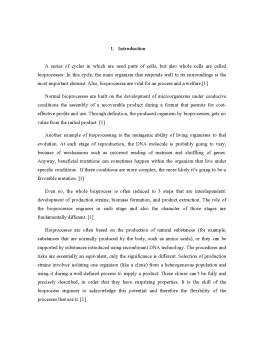Cuprins
- 1. Introduction 3
- 2. Categories 4
- 3. Sustainability 5
- 4. Bibliography 6
Extras din referat
1. Introduction
A series of cycles in which are used parts of cells, but also whole cells are called bioprocesses. In this cycle, the main organism that responds well to its surroundings is the most important element. Also, bioprocesses are vital for an process and a welfare.[1]
Normal bioprocesses are built on the development of microorganisms under conducive conditions the assembly of a recoverable product during a format that permits for cost-effective profits and use. Through definition, the produced organism by bioprocesses, gets no value from the initial product. [1]
Another example of bioprocessing is the mutagenic ability of living organisms to fuel evolution. At each stage of reproduction, the DNA molecule is probably going to vary, because of mechanisms such as incorrect reading of matrices and shuffling of genes. Anyway, beneficial mutations can sometimes happen within the organism that live under specific conditions. If these conditions are more complex, the more likely it’s going to be a favorable mutation. [1]
Even so, the whole bioprocess is often reduced to 3 steps that are interdependent: development of production strains, biomass formation, and product extraction. The role of the bioprocessor engineer in each stage and also the character of those stages are fundamentally different. [1]
Bioprocesses are often based on the production of natural substances (for example, substances that are normally produced by the body, such as amino acids), or they can be supported by substances introduced using recombinant DNA technology. The procedures and risks are essentially an equivalent, only the significance is different. Selection of production strains involves isolating one organism (like a clone) from a heterogeneous population and using it during a well-defined process to supply a product. These clones can’t be fully and precisely described, in order that they have surprising properties. It is the skill of the bioprocess engineer to acknowledge this potential and therefore the flexibility of the processes that use it. [1]
2. Categories
Bioprocesses can be divided into three big categories:
- Cell bioprocessing;
- Upstream bioprocessing;
- Downstream bioprocessing.
Cell bioprocessing
It combines the fields of cell therapy products and bioprocessing (for example, biopharmaceutical manufacturing) and may be a sub-division of biotechnology engineering. It’s primary goal is to determine reproductible manufacturing processes for therapeutic cells production. The great mercantile bioprocesses will: [2]
- At the end of the drug manufacturing, cell bioprocesses help with control costs;
- Help with the assembly of high-quality biopharmaceutical drugs;
- Provide through different stages of development, clinical and also commercial amounts of therapeutic cells. [2]
Bibliografie
[1] C. D, "Bioprocessing Techniques," p. 12, 2011.
[2] R. K. Dr., "Biochemistry," A Gateway to All Post Graduate Courses, p. 33.
[3] A. Barragan-Ocana, P. Silva-Borjas, S. Olmos-Pena and M. Polanco-Olguin, "Biotechnology and Bioprocesses: Their Contribution to Sustainability," Processes, p. 11, 2020.
Preview document
Conținut arhivă zip
- Bioprocesses. Characteristics.docx






